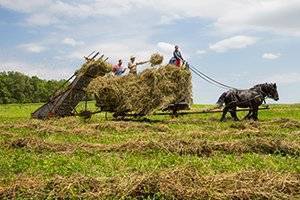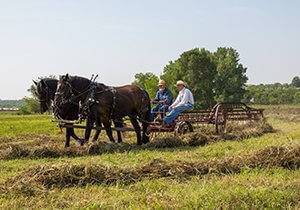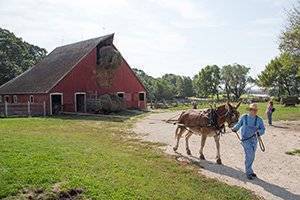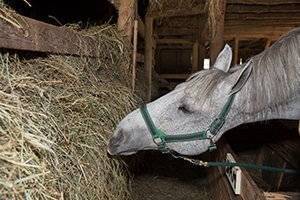what did the change from prairie to farms mean to the animals?
Crops
Hay
 What is Hay?
What is Hay?
Hay is a plant that has been cut, dried, and stored for animal feed. Many plants can be used as hay, merely in Iowa today, alfalfa and clover are the nearly mutual. As Americans moved west onto the Swell Plains in the 19th century, they would oft utilise the prairie grasses that were growing there to feed their livestock.
Hay versus straw: Hay and straw are commonly confused. Hay is made from the stems, leaves, and seed heads of plants that are fresh. Information technology is cut and baled when it has the most nutritional value, and is fed to livestock. Straw is also fabricated from the stems and leaves of plants, simply is cut afterward of the plants accept been immune to mature and the seed heads have been harvested for something else. Straw has very little nutritional value, and is best used equally bedding for animals.
 History of Hay
History of Hay
Many different plants take been used throughout history to feed animals. The first farmers on the prairie would cut the prairie grasses and use them to feed their livestock. Timothy grass and clover, both plants native to Europe, were the almost common plants used for hay in the early 20th century.
Alfalfa quickly replaced timothy and clover after information technology was introduced in Iowa at the end of the 19th century. Alfalfa became the most common constitute for hay. It is believed that alfalfa is native to in central Asia where it was start used to feed animals. Alfalfa spread speedily to all parts of the world. Past the early 1700s, alfalfa was being grown in Central and Due north America. Past the mid-1700s, the British colonies of New York, Virginia, and Georgia all reported growing alfalfa. By the 1850s, alfalfa was being grown in California.
Today, alfalfa is however the main plant for hay.
How Crops Become Hay
In full general, three steps are required to turn a dark-green crop into what can be chosen hay: cutting, drying, and baling. And so, hay must be stored properly in guild for it to hold onto the nutrients. If hay becomes wet, or if it sits in the sun, nutrients can exist lost.
Cut Hay
Cutting hay has been, and can be, done in many ways.
- By hand: For thousands of years, hay was cut with paw-held tools like a scythe.
- Past horse-drawn machine: In the 19th century, many machines that could cutting hay were invented that could be pulled with horses. Many hay mowers were invented in the 19th century.
- By machine pulled by a tractor: When tractors were invented, the hay mower was improved too.
 Drying
Drying
Hay must dry earlier it can be baled. When hay is cutting, farmers exit it in the field and let it to partially dry. Then the farmer will rake the hay into what are called windrows. Rain can harm the hay the well-nigh at this stage. Rain slows downward the drying process, and too much pelting can cause the hay to begin to spoil in the field.
Baling Hay
The first hay baling equipment was invented in the late 1800s. These early baling machines were stationary, and the hay had to come to it. Hay was carried by hand to wagons that then took the hay to these early balers, where the machine pressed the hay into foursquare bales. By the 1930s, hay baling equipment could be pulled by tractors and option up the hay from the ground. This saved the farmer a lot of time and energy!
 Storing Hay
Storing Hay
Stacking is the oldest method of storing hay, and different parts of the world stacked hay differently. On the Iowa prairie in the 1840s and 1850s, these stacks sometimes doubled as housing for animals. As the farm improved, larger barns were congenital that could store more than than just tools and seed. Large barns often held massive amounts of hay stacked in the center. In 1900, loose hay was stored in the befouled. The hay would exist carried by carriage to the befouled where it would be put into the hay loft.
Interesting Facts about Hay
How many acres of hay were harvested in Iowa in these years?
- 1900 – 2,577,000 acres
- 1957 – 3,744,000 acres
- 2016 – 910,000 acres
 How many tons of hay were produced in Iowa in these years?
How many tons of hay were produced in Iowa in these years?
- 1900 – 3,608,900 tons
- 1957 – 7,938,000 tons
- 2016 – 3,210,000 tons
What was the value of the hay crop produced in Iowa in these years?
- 1900 – $23,458,656 (in 1900 era dollars)
- 1957 – $123,039,000 (in 1957 era dollars)
- 2016 – $294,915,000 (in 2016 era dollars)
Sources: 1900:Van Hooten, G. H.The Iowa Yearbook of Agriculture. Des Moines: B. Tater, 1901.1957: Iowa State Department of Agriculture.Second Biennial Report of Iowa Book of Agriculture. Des Moines: Country of Iowa, 1958.2016: The states Department of Agriculture, National Agricultural Statistics Services.
Hay Today
Today, the process for growing hay withal involves letting the plants grow to maturity, then cutting it, letting it dry in the dominicus, raking it, and gathering it up in some form, whether that be round or square bales, or equally loose hay. Farmers today accept different technology and equipment for growing, baling, and storing hay.
 Preparing the soil
Preparing the soil
The land is prepared like it would exist for any other vegetable ingather. Farmers will test the soil to make up one's mind if whatsoever fertilizers need to exist added. If needed the farmer will then add together the advisable amount of fertilizer. The field must exist free from weeds as much as possible. Weeds will go far hard for the alfalfa, clover, or timothy to grow.
Planting and growing
Some fields are always used to abound hay, and don't require re-planting every year. In other cases, hay is a part of a ingather rotation, where farmers plant different crops on the same field in different years. Hayseed can be a mixture of many types of seeds, with alfalfa, clover, and timothy being among the nearly common. The seed tin be planted many ways, from being spread by mitt for small areas, to being planted with machines similar a grain drill.
 Cutting hay
Cutting hay
Cutting hay is done when the hay has the almost nutritional value. Usually that is after about 60 days when harvesting alfalfa for hay. The same field of hay can be cut 2 or three times in the same season. Machines that tin cut hay are chosen mowers.
Today at that place are two types of mowers used to cutting hay that can be pulled by machines.
- Rotary disk mowers have several circular discs that cutting the hay.
- Sickle bar mowers accept a bar with teeth that cut downward the hay.
 Stacking and baling
Stacking and baling
Throughout the 20th century, hay baling equipment continued to ameliorate. In the early part of the century, a machine was invented that could make circular hay bales. Circular hay bales were not common until subsequently a professor and a grouping of students at Iowa Land University came up with a much improved design for a auto that could brand circular bales.
In the mid-1960s, Wesley Buchele, a mechanical engineer at Iowa State Academy, working with graduate students, developed a mechanical baling automobile that would produce a giant, 700 lb. round bale. One person with a tractor could handle these huge bales, from harvest to baling to transporting to feeding livestock, without ever touching the hay. Today, circular bales are the nigh common way to store hay in the United states.
Transporting and Storing
Transporting baled hay to the barn today is done either by moving each bale with a tractor (which takes a long time!) or putting many bales of hay onto a wagon and taking to the barn that way. Today, square or round bales of hay can be stored in a barn or other outbuilding with a roof to protect information technology as much as possible from the weather condition. Hay that is left outside has some sort of covering to protect it from the weather.
Video courtesy of iowadairyboys
 Uses of Hay
Uses of Hay
Feeding hay to livestock is the number one apply for hay.
Most any animal on the farm – horses, cattle, sheep, goats, etc.- will swallow hay. Hay is usually fed to livestock when they cannot graze or be in a pasture, either because it is winter or because of drought. Different animals accept unlike nutritional requirements. Farmers carefully monitor what an brute is eating, to make sure the animals are healthy. If hay spoils, it is not good to feed to animals, equally rotten hay can make livestock sick.
Source: https://www.lhf.org/learning-fields/crops/hay/
Post a Comment for "what did the change from prairie to farms mean to the animals?"